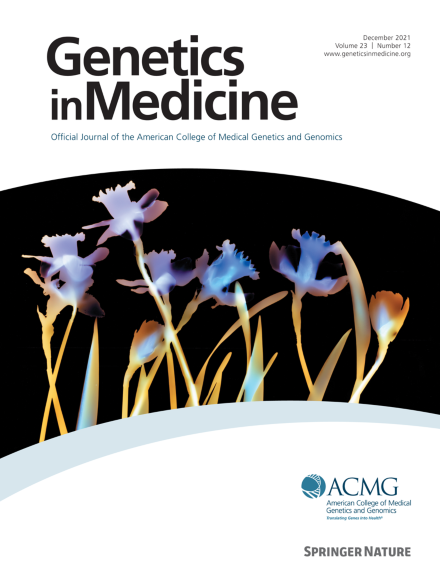在未诊断疾病网络队列中发现新的重复扩展疾病的全基因组方法。
IF 6.2
1区 医学
Q1 GENETICS & HEREDITY
引用次数: 0
摘要
未诊断疾病网络(UDN)是美国国立卫生研究院资助的一项研究,旨在解决具有挑战性的罕见疾病病例的广泛临床范围。参与者接受多名临床专家的护理,他们合作进行深入的表型分析和最先进的多组学分析。随着短读段测序生物信息学的成熟,重复扩增障碍(repeat expansion disorders, red)的发现也在加速。red包括约60种特征性疾病,表现出广泛的表型。因此,在表型多样化的样本中采用一种基本无偏倚的全基因组方法将增加诊断深度,探索短读基因组分析的局限性,并建立新的候选RED位点。方法在此,我们对来自UDN的1,018个基因组的重复序列扩增进行了全基因组分析。通过利用两种不同的生物信息学工具,ExpansionHunter Denovo和STRling,我们发现重复扩增可以在短读基因组中准确检测到。结果表明,基因型优先的方法可以诊断已知的非典型红血球病例,并提供有价值的临床见解。我们提供了ATXN7、DMPK、FMR1、GLS、HTT、RFC1、AFF3和MARCH6扩展患者的临床细节。重要的是,我们强调了通过我们的分析发现的两例青少年亨廷顿病。最后,我们提出了一个新的候选TRs列表,如果扩大,可能具有潜在的致病性。重要的是,我们的方法展示了基因组分析在RED检测中的生物信息学进展,并突出了其实际应用。本文章由计算机程序翻译,如有差异,请以英文原文为准。
A genome-wide approach for the discovery of novel repeat expansion disorders in the Undiagnosed Diseases Network cohort
Purpose
The Undiagnosed Diseases Network is a National Institutes of Health funded research study that aims to solve a broad clinical spectrum of challenging rare disease cases. Participants receive care from multiple clinical specialists, who collaborate to perform deep phenotyping and state-of-the-art multiomics analyses. As bioinformatics of short-read sequencing has matured, the discovery of repeat expansion disorders (REDs) is accelerating. REDs comprise approximately 60 characterized disorders, which exhibit a broad spectrum of phenotypes. Thus, a largely unbiased genome-wide approach in a phenotypically diverse sample will add to the diagnostic depth, explore the limits of short-read genome analysis, and establish novel candidate RED loci.
Methods
Here, we present a genome-wide analysis of repeat expansions conducted on 1018 genomes from the Undiagnosed Diseases Network. By leveraging 2 distinct bioinformatics tools, ExpansionHunter Denovo and STRling, we showed that repeat expansions can be accurately detected in short-read genomes.
Results
We demonstrated that a genotype-first approach can diagnose atypical cases of known REDs and provide valuable clinical insights. We present clinical details on participants with expansions in ATXN7, DMPK, FMR1, GLS, HTT, RFC1, AFF3, and MARCH6. Importantly, we highlight 2 cases of juvenile Huntington disease that were discovered through our analysis. Finally, we present a list of novel candidate short tandem repeats (TR) that could potentially be pathogenic if expanded.
Conclusion
Importantly, our approach showcases the bioinformatic advancements in genome analysis for RED detection and highlights its practical applications.
求助全文
通过发布文献求助,成功后即可免费获取论文全文。
去求助
来源期刊

Genetics in Medicine
医学-遗传学
CiteScore
15.20
自引率
6.80%
发文量
857
审稿时长
1.3 weeks
期刊介绍:
Genetics in Medicine (GIM) is the official journal of the American College of Medical Genetics and Genomics. The journal''s mission is to enhance the knowledge, understanding, and practice of medical genetics and genomics through publications in clinical and laboratory genetics and genomics, including ethical, legal, and social issues as well as public health.
GIM encourages research that combats racism, includes diverse populations and is written by authors from diverse and underrepresented backgrounds.
 求助内容:
求助内容: 应助结果提醒方式:
应助结果提醒方式:


